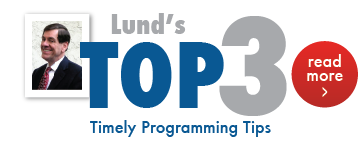Every week, Lund Media’s music and radio programming pros review music software databases for client radio stations. When we first check a client’s music, we can tell how many program directors or music directors have worked on the software over time, resulting in conflicting rules. Stations often forget to clean out old rules that slow the rotations of the listener’s favorite songs.
Depending on how many miles you drive, you take your car in for the required service once a year. When was the last time the music software had a check-up? If it’s been a year, you’re overdue.
Is your music software perfect?
All music software works like a funnel. There’s a big opening at the top with all the songs you might play. Songs drip through the funnel restricted by rules, and fewer songs make the grade.
Give your music software a tune-up. There are six checkups for better music scheduling:
1. Clean out unneeded rules. You probably no longer need those “boy band” or Lady Antebellum rules you had when you played many new songs by those artists. Find rules that duplicate or conflict with each other. Examine your artist, special artist, and group separation rules.
2. Review your tempo controls. Most software programs offer numerous ways to control the pace of your music. It’s best to avoid jarring shifts in tempo and swaths of slow songs. Some PDs prefer to start each sweep or hour with tempo and use rules to stay within a speed range.
3. Stretch your library. Consider gold recycling from midday to the next overnight. These day parts are largely exclusive listening periods, and you can drive the perception of having a larger library without impacting the rotations of your currents.
4. Don’t ask for the impossible. A scheduling rule that says no male artists back-to-back may sound like a good idea for variety, but not if your library is 80% male. The same goes for tempo and genre restrictions.
5. Find artist repeats and conflicts. Check your spelling and spacing on artist names, solo versus group artists like Rob Thomas and Matchbox Twenty, and artist collaborations with other artists. Do not use long-duration artist separation.
6. Refresh your library, especially if your station plays the same songs this week as you did last year. This is essential for gold formats like Classic Rock, Classic Hits, and Classic Country. If you play current music, not all Currents deserve to become Recurrents, and not all Recurrents are strong enough to become Gold. Regardless of your format, play the hits listeners want to hear.
Get your music library and software analyzed by professionals for a precise tune-up. Playing the right songs and managing your software controls are vital to a music station’s success. Lund Media provides a comprehensive music review and software tune-up. We’ll thoroughly examine your library and music software – this is an insurance policy for time spent listening! Contact John@lundradio.com for a cost-efficient analysis and tune-up to help your station capitalize on what listeners want most – the best-researched music for your target demo!



